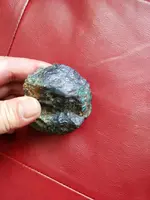Its hard to say. The meteorite experts are well-versed with freshly-fallen material, and also some older larger ones that were buried and stationary. But, the number of meteorite falls per annum has been accurately estimated, and if you take that number and multiply it by the age of the earth, to calculate an approximation of the number of meteorites that have hit Earth in the past 4B years, then divide by the surface area of the Earth, you get a number of meteorites per square meter of the Earth's surface. As most are aware, they also fall atop of glaciers, and like many rocks in glacial till, they get tumbled over time, like in a rock tumbler. So, a 2 billion year old meteorite that's been weathered and tumbled will have a much different appearance than what the experts are accustommed to dealing with. In fact, some true meteorites won't even look like a meteorite. According to Prof. Alvarez's celebrated theory, iridium content can be a telltale sign. I've got one that analyzed at 0.1% iridium by XRF, which is a hefty amount and also given that Ir in the Earth's crust is essentially non-existent. If you want to see what some meteorites look like, look up a fellow named Robert Haag, he has a big catalog on the internet you can leaf through and get a feel for the different classifications of meteorites !!





